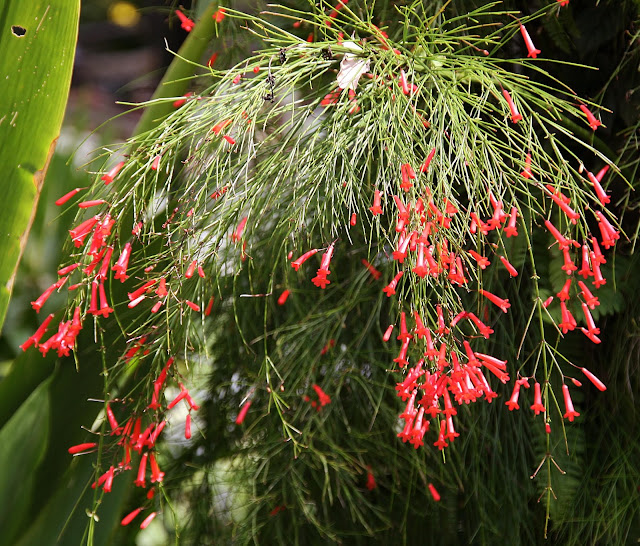Russelia equisetiformis inflorescence S. Reeve
| This plant is not new to me, I have always admired Russelia equisetiformis or firecracker flower, but didn't live where I could grow it. Mistakenly, I thought it was a tough plant to grow. Up until it got hot this summer I was pretty sure it was a tough plant to grow. You see I planted it about 6 months ago and it just sat there. I bought from a vendor on Ebay because they grew this without neonicotinoid pesticides. Before I buy a plant I need assurance it is not grown using these systemic pesticides as they harm wildlife, especially bees. The spot I chose was at the edge of a stucco wall so my thought was it will cascade down eventually. Well, this little sleeper plant exploded in growth once it was over 80 degrees F. It quickly increased in size by 4-6 times its original size. Heat lovers definitely have a place here in my summer hot garden (and getting hotter-thank you global warming!). Also, when we had those couple days of odd temperature spikes in the mid-90s and many of my plants exhibited some kind of heat damage, while this plant did not.
Young immature plant starting to cascade
This is a medium green evergreen shrub-like cascading plant with flowers from spring until frost. I wonder if it will keep flowering if there is no frost? That would be nice. From what I am reading it can bloom year round in frost-free gardens. This plant comes from Mexico and Latin America. Of course, the 1 inch long red flowers are pollinated by hummingbirds and that is why it is in my garden! Formerly in the Scrophulariaceae family and now in the Plantaginaceae. The species name, "equisetiformis" refers to its similarity to horsetail rush or Equisetum. Russelia refers to Scottish naturalist Alexander Russell from the 1700s. Skinny stems are angular and rush-like and the leaves have been reduced to scales. Young wiry stems grow vertically for a time and eventually turn downward in a free fall pendulous fashion. New stems just starting out give the plant a 'bad hair day" look. With time the stems increase and the flowers increase it is definitely in the Cousin Itt category with a dense mound of foliage and flowers.
Planted as a hedge
There several selections of colors, there is red of, course, but also coral, white, orange, pink, and yellow flowers. There is a closely related species of Russelia called Russelia sarmentosa with smaller red flowers that is more shrub-like.
Photo by Alan Lorence
Technically the inflorescence is a terminal cyme, but unlike a single-flowered terminal cyme, as most are, this plant has paired terminal flowers or a "pair-flowered" cyme. Only three families have this condition. Here is a diagram of a normal cyme and a pair-flowered cyme so you can see the difference. These diagrams are from the Annals of Botany.
Anton Weber; Pair-flowered cymes in the Lamiales: structure, distribution, and origin, Annals of Botany, Volume 112, Issue 8, 1 November 2013, Pages 1577–1595, https://doi.org/10.1093/aob/mct156
Ordinary Cyme with single flower terminating each cyme unit
Pair-flowered cyme with two terminal flowers in each cyme unit
Close up of individual flowers S. Reeve
Little blackish-red pearl-like buds open up into the coral-red bilaterally symmetrical tubular flowers. You can barely see two of four stamens bearing pollen and a black female stigma. Looking at the arrangement it is easy to see that if the hummingbird sticks its beak in this flower she will have pollen deposited on her only to have it make contact with the stigma in the next flower she visits. Nice system Russelia!
This plant is not just another pretty face. It has many uses in pharmacology. In Nigeria, it is used to promote hair growth, to treat malaria, cancer, diabetes, and inflammatory disorders. In Colombia it is used for kidney stones. The plant has antibacterial, antimicrobial, antioxidant, analgesic, and cytotoxic properties.
This plant can reach 4 feet long and much wider at maturity. It looks wonderful draped over a wall and growing in a tall pot. Can you imagine this in a tall chartreuse ceramic pot? Nice!
This plant needs well-drained soil, full sun, and heat. It can even grow in a hot place like Phoenix. Sunset Western Garden book says it needs moderate to regular water and can take temperatures down to 20 degrees F. I don't water mine that much and it looks fine. I have also read more water and fertilizer results in much better lusher growth. I am not much of a fertilizer user but I might try an organic fertilizer on it and some extra water to see what happens. Right now, I water once a week and it is the summer and it is doing just great. The stems can root where they touch the ground if the soil is kept moist. You can also start new plants with stem tip cuttings or layering. I love this plant because it is easy and because it throws out an abundance of bright red flowers for me and the hummingbirds.
|











